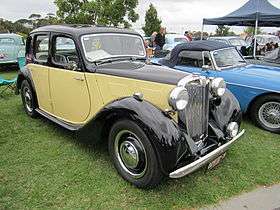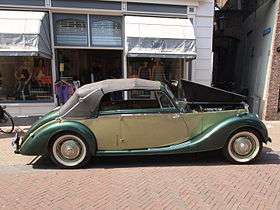Morris Motors
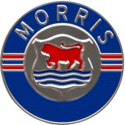 | |
| Industry | Automotive |
|---|---|
| Fate |
Individual identity retained until 1968 Ownership merged with Austin in 1952 as subsidiaries of The British Motor Corporation Limited |
| Successor | The British Motor Corporation Limited |
| Founded |
1912 W.R.M. Motors 1919 renamed Morris Motors |
| Defunct | brand name used until 1984 |
| Headquarters | Cowley, Oxford, Oxfordshire, later Longbridge England |
Key people |
William Morris, 1st Viscount Nuffield Frank George Woollard Leonard Lord |
| Products | motor cars |
| Subsidiaries |
Morris Commercial Cars Limited, Nuffield Acceptances Limited, Nuffield (Australia) Limited, Nuffield Exports Limited, Nuffield Mechanizations Limited Nuffield Metal Products Limited, The Nuffield Press Limited, Nuffield Tools and Gauges Limited, Riley (Coventry) Limited, Riley Motors Limited, The M.G. Car Company Limited, The S.U. Carburetter Company Limited, Wolseley Motors Limited |
| Product type | Automotive |
|---|---|
| Owner | SAIC |
| Discontinued | 1984 |
| Previous owners |
W. R. Morris (1912–1952) |
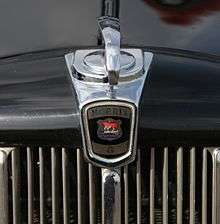
Morris Motors Limited was a British motor vehicle manufacturer formed in 1919 to take over the assets of WRM Motors Ltd., which had been put into voluntary liquidation. Though merged[note 1] into larger organisations, the Morris name remained in use until 1984 when British Leyland's Austin Rover Group decided to concentrate on the more popular Austin brand. The trademark is currently owned by the China-based automotive company SAIC after being transferred from bankrupt subsidiary Nanjing Automotive.
The company is more notable for Morris Minor, Morris Mini a.k.a Mini Cooper and Morris Oxford series III, which would later be manufactured by Hindustan Motors as Hindustan Ambassador with periodic enhancements in India till 2014.
Today, the former Morris manufacturing complex at Cowley, Oxford survives as Plant Oxford, and is owned by the BMW Group as the headquarters of the MINI marque and associated family of vehicles.
History
Early history
WRM Motors Ltd began in 1912 when bicycle manufacturer William Morris moved on from the sale, hire, and repair of cars to car manufacturing. He planned a new light car assembled from bought-in components. In this way he was able to retain ownership by keeping within the bounds of his own capital resources.
A factory was opened in 1913 at former Oxford Military College at Cowley, Oxford, United Kingdom where Morris's first car, the 2-seat Morris Oxford "Bullnose" was assembled.[1] Nearly all the major components were bought-in.
In 1914 a coupé and van were added to the line-up but the Bullnose chassis was too short and the 1018 cc engine too small to make a much-needed 4-seat version of the car. White and Poppe, who made the engine, were unable to supply the volume of units that Morris required, so Morris turned to Continental of Detroit, Michigan for the supply of a 1548 cc engine.[1] Gearboxes and axles were also sourced in the US.
In spite of the outbreak of the First World War the orders were maintained and, from mid-1915 a new larger car, the 2-seat and 4-seat Morris Cowley was introduced.
Inter-war years
After the war the Continental engine was no longer available so Morris arranged for Hotchkiss of France to make a near-copy in their Coventry factory. This was used to power new versions of the basic Cowley and more up-market Morris Oxford cars.
With a reputation for producing high-quality cars and a policy of cutting prices, Morris's business continued to grow and increase its share of the British market overtaking Ford to become in 1924 the UK's biggest car manufacturer, holding a 51% share of the home market and remaining enormously profitable.
Possessed of a very large cash income Morris had a policy of personally buying up suppliers' businesses. For example, in 1923 he bought Hotchkiss's Coventry business which later became Morris Engines branch. He also brought in F G Woollard which became Morris Commercial Cars to lead the re-organization of their engine production from batch to flow, thus increasing output from less than 300 units per week to 1200. By 1924 the factory was making 2000 units a week with only a small increase in work space and labour force.[2]
Cecil Kimber, head of Morris's own original 1909-founded Morris Garage sales hire and repair operation in Oxford, began building sporting versions of Morris cars in 1924 labelling them MG. They were so successful a separate MG factory was soon established south of Oxford in Abingdon, Oxfordshire.
Having admired Budd's all-steel bodies Morris founded The Pressed Steel Company of Great Britain Limited in 1926 as a joint venture with Edward G Budd Manufacturing Company - Budd International of Philadelphia, USA.[3] Pressed Steel's factory was located over the road from Morris's factory at Cowley and supplied Morris and many other motor manufacturers. Morris withdrew from the venture in mid-1930. Budd sold their share to British interests at the beginning of 1936.[4]

The small car market was entered in 1928 with the Leonard Lord-designed Morris Minor using an 847 cc engine from Morris's newly acquired Wolseley Motors. Lord had been sent there to modernise the works and Wolseley's products. The Minor was to provide the base for the MG Midgets. This timely spread into the small car market helped Morris through the economic depression of the 1930s. At the 1934 London Motor Show the Minor was replaced by the Morris Eight, a direct response to the Ford Model Y and, though Leonard Lord's handiwork, heavily based on it.
In 1932 W R Morris appointed Lord Managing Director of Morris Motors Limited and Lord swept through the Morris works, updating the production methods, introducing a proper moving assembly line and creating Europe's largest integrated car plant.[5] But Morris and Lord fell out, and after 15 years Lord left in 1936 – threatening to "take Cowley apart brick by brick".[6] Lord moved to Austin and they were to meet again in BMC —Morris, as Lord Nuffield, its first chairman. Lord succeeded him.
As of 1 July 1935 Morris Motors acquired from W R Morris, now Lord Nuffield, in exchange for a further issue of ordinary shares to him, the car manufacturing businesses of Wolseley Motors Limited and The MG Car Company Limited. A separate private company, Wolseley Aero Engines Limited, was then formed to continue the development of his aviation interests.[7]
In 1936 Lord Nuffield sold Morris Commercial Cars Limited, his commercial vehicle enterprise, to Morris Motors.[8] In 1938 William Morris, Baron Nuffield, became Viscount Nuffield, the same year he transferred his newly acquired[9] Riley car business to Morris Motors Limited for £100.[10]
Iron Lung
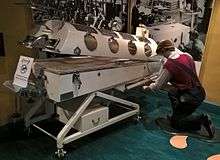
Visiting London in 1938 during a polio epidemic, Lord Nuffield saw a Both Iron Lung in use. He commissioned an improved design of a version of this using which could be produced using the techniques of car assembly and financed the production of approximately 1700 machines at the Cowley works which he donated to hospitals throughout all parts of Britain and the British Empire.[11] Soon, the Both-Nuffield respirators were able to be produced by the thousand at about one-thirteenth the cost of the American design.[12]
Car production in Britain 1919-1938 (per cent)
| 1919 | 1921 | 1923 | 1925 | 1927 | 1929 | 1932 | 1935 | 1938 | ||
|---|---|---|---|---|---|---|---|---|---|---|
| [13] | Morris | 2 | 10 | 28 | 42 | 37 | 35 | 33 | 31 | 23 |
| Austin | 7 | 8 | 10 | 23 | 25 | 27 | 23 | 21 | ||
| Ford | 22 | 11 | 2 | 6 | 4 | 6 | 17 | 18 | ||
| Rootes Standard Vauxhall | 8 | 23 | 23 | 31 | ||||||
Significant subsidiaries
| Subsidiary | founded or acquired
by W R Morris, |
acquired by Morris Motors Limited |
|---|---|---|
| MG | 1909 | 1935 |
| W R Morris | 1912 | 1926 |
| Morris Engines | 1923 | 1926 |
| Morris Commercial | 1923 | 1936 |
| Nuffield Press | 1925 | |
| Pressed Steel | 1926 | never |
| SU | 1926 | 1926 |
| Wolseley | 1927 | 1935 |
| Nuffield Mechanizations | 1935 | WWII |
| Riley | 1938 | 1938 |
Second World War

In the summer of 1938 Morris agreed to build equip and manage a huge new factory at Castle Bromwich, which was built specifically to manufacture Supermarine Spitfires.[14] After a major air raid damaged the Morris Bodies factory, the premises switched to the production of jerry cans, producing millions of these versatile containers for use during the rest of the war and following the ending of hostilities.[15] The Cowley plant was turned over to aircraft repair and production of Tiger Moth pilot trainers, as well as "mine sinkers" based on a design produced at the same plant during the First World War.[15]
Post-World War II production
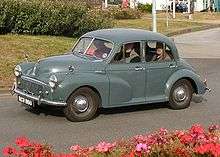
Production restarted after World War II, with the pre-war Eight and Ten designs. In 1948 the Eight was replaced by what is probably the most famous Morris car, the Morris Minor designed by Alec Issigonis (who later went on to design the Mini) and reusing the small car name from 1928. The Ten was replaced by a new 1948 Morris Oxford MO, styled like a larger version of the Minor. A later Morris Oxford (the 1956 Morris Oxford III) was the basis for the design of India's Hindustan Ambassador, which continued in production until 2014.
| The nine different cars made by Morris Motors and its wholly owned subsidiaries at the time of the formation of BMC | ||||||||||
|---|---|---|---|---|---|---|---|---|---|---|
|
|
|
They used six engines and five (and a half) car bodies, of which the "specialist" three were obsolescent, the rest very closely related if not identical.
BMC
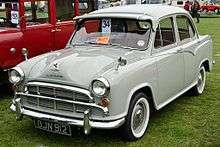
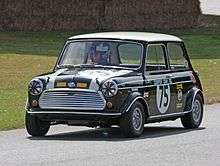
In 1952 the Nuffield Organisation merged with its old rival the Austin Motor Company to form the British Motor Corporation (BMC). Nuffield brought the Morris, MG, Riley and Wolseley marques into the merger. Leonard Lord was in charge, which led to Austin's domination of the organisation. Badge-engineering was important to BMC and for many years the various marques would be seen on several families of similar vehicles.
British Leyland
In 1966, BMC acquired Jaguar to create British Motor Holdings (BMH), which subsequently merged with Leyland Motors in 1968 to form the British Leyland Motor Corporation (BLMC), and subsequently, in 1975, the nationalised British Leyland Limited (BL). The Cowley complex remained the second largest single facility in the BL empire (after Longbridge), but BL's history was a turbulent one - BMC was in fact close to financial ruin, and the newly installed Leyland management failed to turn its fortunes around.
The Morris marque continued to be used until the early 1980s on cars such as the Morris Marina. The Morris Ital (essentially a facelifted Marina) was the last Morris-badged passenger car, with production ending in the summer of 1984. The last Morris of all was a van variant of the Austin Metro.
After much restructuring of BL in the late 1970s and early 1980s, the former Morris plant at Cowley and its sister site the former Pressed Steel plant, were turned over to the production of Austin and Rover badged vehicles. They continued to be used by BL's Austin Rover Group and its successor the Rover Group, which was eventually bought by BMW, and then by a management consortium, leading to the creation of MG Rover. None of the former Morris buildings now exist, British Aerospace sold the site in 1992, it was than demolished and replaced with the Oxford Business Park. The adjacent former Pressed Steel site (now known as "Plant Oxford") is owned and operated by BMW, who use it to assemble the new MINI.
The rights to the Morris marque are currently owned by Nanjing Automobile (Group) Corporation.
The history of William Morris's business is commemorated in the Morris Motors Museum at the Oxford Bus Museum.
Post-Morris cars to have been built at Cowley include the Austin/MG Maestro, Austin/MG Montego, Rover 600, Rover 800 and (for a short time) the Rover 75.
Badge
The Morris badge shows an ox fording the River Isis, the traditional emblem of William Morris's home town of Oxford, used in the coat of arms of Oxford.[16]
Car models (excludes light vans)

.jpg)
.jpg)
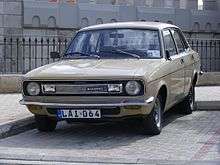
- 1913–1926 - Morris Oxford bullnose (12 or 14 hp)
- 1915–1931 - Morris Cowley bullnose and flatnose (12 or 14 hp)
- 1923–1924 - Morris Oxford Six F series (18 hp)
- 1926–1930 - Morris Oxford flatnose (12 or 14 hp)
- 1926–1929 - Morris Oxford 15.9 and 16/40 (16 hp)
- 1927–1929 - Morris Six (18 hp)
- 1929–1935 - Morris Isis (18 or 25 hp)
- 1928–1932 - Morris Minor (8 hp)
- 1929–1935 - Morris Oxford Six, Sixteen and Twenty (16 or 20 hp)
- 1931–1934 - Morris Cowley (12 or 14 hp)
- 1931–1933 - Morris Major (15 hp then 14 hp)
- 1932–1948 - Morris Ten (10 hp)
- 1933–1935 - Morris Ten Six (12 hp)
- 1933–1935 - Morris Cowley Six (14 hp)
- 1933–1939 - Morris Big Six Twenty-One/Twenty-Five (21 or 25 hp)
- 1934–1939 - Morris Twelve (12 hp)
- 1935–1939 - Morris Fourteen (14 hp)
- 1935–1948 - Morris Eight (8 hp)
- 1948–1952 - Morris Minor MM (8 hp)
- 1952–1956 - Morris Minor
- 1956–1971 - Morris Minor 1000
- 1948–1954 - Morris Oxford MO (14 hp)
- 1948–1953 - Morris Six MS
- 1954–1956 - Morris Oxford series II
- 1954–1959 - Morris Cowley
- 1955–1958 - Morris Isis
- 1956–1959 - Morris Oxford series III
- 1957–1960 - Morris Marshal (BMC Australia)
- 1958–1964 - Morris Major (BMC Australia)
- 1959–1971 - Morris Oxford Farina
- 1959–1969 - Morris Mini Minor
- 1964–1968 - Morris Mini Moke (United Kingdom)
- 1966–1973 - Morris Mini Moke (Australia)
- 1962–1971 - Morris 1100
- 1967–1971 - Morris 1300
- 1968–???? - Morris 11/55 (South African market variant of Morris 1100) [17]
- 1969–1972 - Morris 1500 (Australia)
- 1966–1975 - Morris 1800
- 1972–1975 - Morris 2200
- 1969–1972 - Morris Nomad (Australia)
- 1971–1980 - Morris Marina
- 1980–1984 - Morris Ital
Morris-badged tractors
| Model | Year(s) of production | Horsepower | Engine type | Notes |
|---|---|---|---|---|
| Morris-Leyland 154 | 28 hp (21 kW) | built by BMC Sanayi in Turkey | ||
| Morris-Leyland 184 | built by BMC Sanayi in Turkey | |||
| Nuffield Morris 10/60 | 60 hp (45 kW) | built by BMC Sanayi in Turkey | ||
See also
Note
- ↑ . . . although nearly twenty-five years had elapsed since the BMC merger, not even Austin and Morris, the two volume car manufacturers that formed the core of the original merger, had integrated to a significant degree. Stokes illustrated the immensity of the problem presented by the merger in 1968 by referring to the former Austin and Morris companies having been 'scarcely on speaking terms'. Sixteen years after the formation of BMC, like the other former Nuffield companies and Jaguar, each possessed different management systems, approaches and methods, and like the other companies in the group they were 'running on their own'. H. C. Reports, Accounts and Papers, XXV, Fourteenth Report of the Expenditure Committee, Minutes of Evidence (1974–75), Vol. II, q. 2171 quoted in Historical foundations of Corporate culture: British Leyland, its predecessors and Ford. Roy Church. Business history and business culture. Edited by Andrew Godley, Oliver M. Westall, Manchester University Press, 1996
References
| Wikimedia Commons has media related to Morris Motors. |
- 1 2 Georgano, N. (2000). Beaulieu Encyclopedia of the Automobile. London: HMSO. ISBN 1-57958-293-1.
- ↑ G. T. Bloomfield, ‘Harriman, Sir George William (1908–1973)’, Oxford Dictionary of National Biography, Oxford University Press, 2004
- ↑ Offer for sale of shares - Pressed Steel Company Limited. The Times, Tuesday, 7 April 1936; p. 21; Issue 47343
- ↑ Pressed Steel Company.The Times, Friday, 10 January 1936; p. 19; Issue 47268
- ↑ R. J. Overy, ‘Morris, William Richard, Viscount Nuffield (1877–1963)’, Oxford Dictionary of National Biography, Oxford University Press, 2004
- ↑ Graham Turner, The Leyland Papers, London 1971, p. 91
- ↑ Wolseley And M.G. Companies.The Times, Friday, 14 June 1935; p. 20; Issue 47090.
- ↑ Morris Motors Limited, Notice issued in compliance with . . . The Times, Tuesday, 13 October 1936; p. 22; Issue 47504.
- ↑ Riley Motors. Purchase by Lord Nuffield, The Times, Saturday, 10 September 1938; p. 17; Issue 48096
- ↑ Obituary, Mr. Victor Riley. The Times, Tuesday, 11 February 1958; p. 10; Issue 54072
- ↑ Langmore, Diane, ed. (2009). Australian Dictionary of Biography: Volume 17 1981-1990 A-K. Carlton, Victoria: Melbourne University Publishing. p. 129. ISBN 978-0522853827.
- ↑ Healey, John (1998). "The Both Brothers and the 'Iron Lung'". South Australian Medical Heritage Society Inc. Retrieved 10 June 2016.
- ↑ Roy A Church, The Rise and Decline of the British Motor Industry, p. 39, Cambridge University Press 1995 ISBN 0521552834
- ↑ Castle Bromwich Retrieved: 9 February 2008.
- 1 2 "Sixty Years of Morris". Autocar. 138 (nbr 4022): 4–9. 28 June 1973.
- ↑ Hillinger, Ellis (25 June 2000). "Morris Automotive Heraldry". Retrieved 11 January 2014.
- ↑ Timeline 1968, www.ado16.info Retrieved on 26 September 2013
| British Leyland – car companies and marques | |||||||||||||||||||||||||||||||||||||||||||||||||||||||||||||
|---|---|---|---|---|---|---|---|---|---|---|---|---|---|---|---|---|---|---|---|---|---|---|---|---|---|---|---|---|---|---|---|---|---|---|---|---|---|---|---|---|---|---|---|---|---|---|---|---|---|---|---|---|---|---|---|---|---|---|---|---|---|
| Marque | 1900s | 1910s | 1920s | 1930s | 1940s | 1950s | 1960s | 1970s | 1980s | 1990s | 2000s | 2010s | |||||||||||||||||||||||||||||||||||||||||||||||||
| Jaguar | SS Cars | Jaguar | Jaguar & Daimler |
BMH | BLMC / British Leyland | Jaguar & Daimler |
Ford (PAG) | Tata | |||||||||||||||||||||||||||||||||||||||||||||||||||||
| Daimler | Daimler | BSA | BSA | ||||||||||||||||||||||||||||||||||||||||||||||||||||||||||
| Lanchester | Lanchester | ||||||||||||||||||||||||||||||||||||||||||||||||||||||||||||
| Rover | Rover Company | Rover Company | Rover Company | Austin Rover Group & Land Rover Group (BL plc) |
Rover Group (BAe) | Rover Group (BMW) |
MG Rover Group (PVH) | ||||||||||||||||||||||||||||||||||||||||||||||||||||||
| Land Rover | Ford (PAG) | ||||||||||||||||||||||||||||||||||||||||||||||||||||||||||||
| Alvis | Alvis | BAE Systems | |||||||||||||||||||||||||||||||||||||||||||||||||||||||||||
| Standard | Standard | Standard Triumph | Leyland Motors | British Motor Heritage | |||||||||||||||||||||||||||||||||||||||||||||||||||||||||
| Triumph | Dawson | Triumph | BMW | ||||||||||||||||||||||||||||||||||||||||||||||||||||||||||
| Riley | Riley | Nuffield Organisation | BMC | BMH | |||||||||||||||||||||||||||||||||||||||||||||||||||||||||
| MG | Morris Garages (MG) | Rover Group (BMW) |
MG Rover Group (PVH) | SAIC & NAC |
SAIC | ||||||||||||||||||||||||||||||||||||||||||||||||||||||||
| Morris | Morris | Morris | |||||||||||||||||||||||||||||||||||||||||||||||||||||||||||
| Wolseley | Wolseley | ||||||||||||||||||||||||||||||||||||||||||||||||||||||||||||
| Austin | Austin | Austin | |||||||||||||||||||||||||||||||||||||||||||||||||||||||||||
| Vanden Plas | Vanden Plas | ||||||||||||||||||||||||||||||||||||||||||||||||||||||||||||
| Mini | BMW | ||||||||||||||||||||||||||||||||||||||||||||||||||||||||||||
| Princess | BMC | BLMC / British Leyland | |||||||||||||||||||||||||||||||||||||||||||||||||||||||||||
| Austin-Healey | Austin (BMC) & Donald Healey | ||||||||||||||||||||||||||||||||||||||||||||||||||||||||||||
| Marque | 1900s | 1910s | 1920s | 1930s | 1940s | 1950s | 1960s | 1970s | 1980s | 1990s | 2000s | 2010s | |||||||||||||||||||||||||||||||||||||||||||||||||


